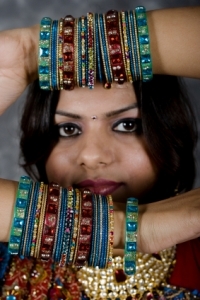Common Hindu symbols
By Catalogs Editorial Staff

Learn about the meaning and history of Hindu symbols.
What are the most important parts of a religion? There are the rituals, the books, the history and the symbols. When it comes to understanding the particular beliefs of a faith, looking at the religious symbols is a good way to start. Hindu symbols are fascinating – full of mysticism and history. I’ve seen many Hindu symbols before, but had no idea what they actually represent.
Symbols Associated with a Puja (Prayer) or Ceremony
- Tilaka: The tilaka is a mark worn on the forehead as a sign of devotion. The shape of the tilaka can indicate devotion to a specific Hindu deity. A U-shaped tilaka symbolizes devotion to Vishnu, the Preserver. Three horizontal lines symbolize devotion to Shiva, the Destroyer. A tilaka is usually made of the spices saffron or turmeric or out of the pigment vermilion. It is sometimes simply made of clay or ash. Ash used for a tilaka comes from prayer rites that involve fire. It shows that the body comes from dust and ash and will return to the same state.
- Bindi or pottu: Called a bindi in northern India and a pottu in southern India, this is a vermilion dot on the forehead of a married woman. The exact placement on the forehead can indicate what region the woman is from.
- Aum, Om: The Aum is both a sound and symbol that represent Brahman, the Supreme Spirit. The sound is often used at the beginning and end of mantras (chants) or prayers. It is a sound made by the voice that moves through all the vowel sounds and represents the vibration that is divine. The written form is a symbol recognized worldwide by Hindus.
- Rudraksha: The seeds of the Rudraksha tree represent the tears of Shiva, the Destroyer. They are made into a kind of rosary to use during prayer.
- Sri Chakra Yantra: This symbol is of nine interlocking triangles. Four upright triangles represent Shiva, or the masculine. Five inverted triangles represent Shakti, the Divine Mother, or the feminine. Together, the nine triangles form a web that represents the cosmos.
- Swastika: Although the swastika is reviled as a hate-filled symbol of Nazism, the swastika has been used in Hinduism since ancient times. It represents purity of the soul, truth and stability. It sometimes represents the sun. The Nazis adapted it by tilting it on its side and took it to symbolize purity of race.~
Symbols Associated with Certain Devas, or Deities
- Shiva Lingam: The Shiva Lingam is usually shown as a phallus-shaped column. It represents Shiva, and is also a symbol of fertility and strength.
- Lotus: The lotus flower is a symbol associated with creation, and with the gods Vishnu the Preserver, Brahma the Creator and Lakshmi (goddess of wealth, fortune, love and beauty). Lakshmi is also symbolized by an owl.
- Veena: The veena is a musical instrument that represents art and learning, and is a symbol of Saraswati, who is the goddess of art, music, and knowledge. Saraswati is also associated with the peacock, the swan, and the color white.
- Conch shell: In Hinduism, the conch shell is often blown as an announcement of prayer, and at certain times during religious services. It is connected to Vishnu, the Preserver.
- Dharmacakra: Also called the Wheel of Dharma, this is a symbol that represents Hindu dharma, or law. It appears as a wheel with eight or more spokes. This symbol is also significant to Buddhists.
Hinduism is full of symbols, and each one holds a key to understanding the Hindu faith. I’ve mentioned some of the most well-known, but there are many other symbols that are important to followers of Hinduism.
Popular Savings Offers











